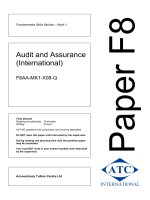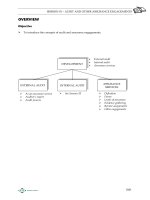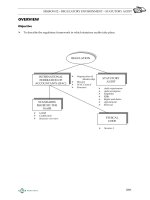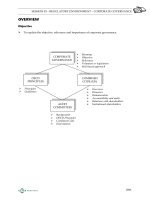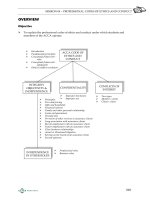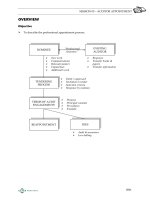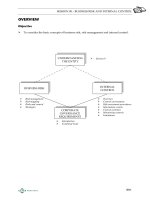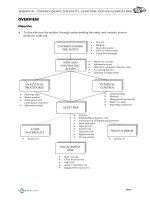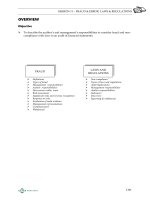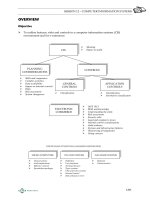ATC f8 materials for jun08 session study systemf8 AA (int)session05 j08
Bạn đang xem bản rút gọn của tài liệu. Xem và tải ngay bản đầy đủ của tài liệu tại đây (312.57 KB, 16 trang )
SESSION 05 – AUDITOR APPOINTMENT
OVERVIEW
Objective
To describe the professional appointment process.
EXISTING
AUDITOR
“Professional
clearance”
NOMINEE
New work
Communications
Relevant matters
Unpaid fees
Additional work
TENDERING
PROCESS
TERMS OF AUDIT
ENGAGEMENTS
REAPPOINTMENT
Response
Transfer books &
papers
Transfer information
Entity’s approach
Invitation to tender
Selection criteria
Response by nominee
Purpose
Principal contents
Procedures
Example
FEES
Audit & assurance
Low balling
0501
SESSION 05 – AUDITOR APPOINTMENT
1
NOMINEE
1.1
New professional work
1.1.1
Reasons
Reasons why the entity may wish to change their auditor include:
the entity is seeking to obtain better value for money in the provision of audit and
other professional services and/or a wider range of services;
on change of ownership of an entity (eg as a result of takeover, merger or MBO);
when audit firms merge (eg a conflict of interests arises, or the entity considers that
the new firm is too large to give a “personal service”);
users of the financial statements and providers of finance (eg banks) expect
organisations achieving a size or status (eg being listed on a recognised Stock
Exchange) to have multinational accountancy firms as auditors;
if a vacancy arises through the death or incapacity of the auditor.
The prospective accountant/auditor may be recommended directly to the potential
client or they may be asked to compete against other firms as part of a tendering process
(see Section 4).
1.1.2
Procedures
An accountant/auditor who is asked to accept a new accountancy/audit appointment
should:
Determine whether there are any professional or other reasons for not accepting the
assignment by contacting the current accountant/auditor.
Obtain a reasonable understanding of the business and its environment, the
complexity of the potential client, the management and control environment,
related parties, governance procedures, regulatory and other (non-statutory audit)
reporting requirements, selection and application of accounting policies (see Session
9).
Assess the specific requirements of the engagement and the purpose, nature and
scope of the work to be performed (eg possible use of experts, reliance on internal
audit). Together with understanding the business (as above) this enables the
prospective auditor to assess whether or not they can service the client properly.
Assess the risks to compliance with the fundamental principles (e.g. integrity,
objectivity, professional competence, independence, fee level, conflicts of interests,
other services required, availability of audit staff, timing of services – see Session 4).
Assess the business risk to the auditor of being associated with, conducting
business with, and auditing, the new client (eg recovery of fees, integrity of
management, risk of business failure). This process is often referred to as ‘client
screening’.
0502
SESSION 05 – AUDITOR APPOINTMENT
In some jurisdictions it is a legal requirement (eg under money laundering
procedures) to undertake procedures to “verify the identity” of the potential client.
With major, international entities such procedures will be straight forward, but for
small entities with, say two directors, extensive checks and references on the entity
and its directors may be necessary (eg to verify that the entity is a bona-fide entity
and not just a “pocket entity” for the purpose of money laundering).
Note that as an audit appointment is generally for one year only, similar procedures
will be carried out as part of the review and closedown process of the current audit (see
Session 29) and before accepting appointment as auditor for the next year (see Section 6).
Commentary
The ACCA’s “Professional appointments” references to “accountant” apply equally to
“auditor” and “reporting accountant”. The term “auditor” is used throughout the
remainder of this session.
1.2
Communication with current auditor
Request prospective client to write to the current auditor to inform them of the
proposed change and to give permission for them to discuss the client’s affairs with the
prospective auditor. Without the client’s permission, the current auditor will not be
able to discuss the client’s affairs as it would be a breach of confidentiality.
Request prospective client’s permission to communicate with the existing auditor. This
should be in writing. If permission is refused by the potential client, decline to accept
the appointment.
With permission, write to existing auditor requesting information relevant to deciding
whether or not to accept the appointment, eg if there has been any action by the client
which would on ethical grounds mean declining to accept appointment.
On receipt of a reply, assess any issues raised as they impact upon the acceptance of the
engagement and that the prospective client is an entity the auditor wishes to be
associated with.
If current auditor/adviser does not respond within a reasonable time:
phone or fax, and if no reply send a final letter by recorded delivery stating that “no
matters” will be assumed unless advised otherwise and if still no reply;
seek to obtain information about potential threats from other sources (may require
client’s permission depending on source), e.g. enquiries of third parties, those
charged with governance, audit committee;
report current auditor to their professional body (eg the ACCA) for unprofessional
behaviour.
Any information received from the current auditor must be treated with the strictest
confidence.
0503
SESSION 05 – AUDITOR APPOINTMENT
1.3
Relevant matters to consider
Any information supplied by existing auditors should be considered carefully before
deciding to accept or reject the appointment.
Prospective auditors should try to find out the reason for the change of auditors. They
should be careful that by accepting an appointment they are not assisting clients to act
improperly or unlawfully.
For example, prospective auditors may find that the existing auditors have been
conscientious in their duty as independent professionals, but have encountered
client opposition. The existing auditors may have declined to give way on what
they consider to be a matter of principle. In such circumstances prospective
auditors should probably decline appointment.
If there is a conflicting view between client and current auditor/adviser that has lead to
the potential replacement of the auditor, discuss with the client to be satisfied that:
client’s view can be accepted as reasonable; and that
client will accept that prospective auditor may express a similar opinion to the
current auditor.
If not, the appointment should be declined.
If the client failed or refused to supply the existing auditor with information properly
required by them to fulfil their duties, in all probability they will do the same to the new
auditor. This is effectively a limitation on scope applied by the client and as
forewarned, the prospective auditor should probably decline appointment.
Unlawful acts or defaults by the client (e.g. defrauding taxation authorities) place the
prospective auditor on guard as to the integrity of the client. Such matters must be
carefully discussed with the client to establish if they are prepared to accept the advice
offered. If not, decline appointment.
1.4
Unpaid/overdue fees to existing auditor
Existence of unpaid/overdue fees is not of itself a reason for not accepting nomination
(nor the current auditor refusing to co-operate with the prospective auditor).
It is a matter of discussion between the auditors as to how much assistance the new
auditor will give to recover the fees of the old auditor.
Prospective auditors would normally be expected to draw the attention of their client to
the fact that fees are due and unpaid and to suggest that they should be paid
1.5
Additional professional work
A member invited to undertake work additional to continuing work carried out by the
client’s existing auditor who is not being replaced or superseded, should notify the
existing auditor of the work they have been asked to undertake, before accepting such
work. In doing so, the existing auditor will be able to provide any relevant information
needed for the proper conduct of the work.
0504
SESSION 05 – AUDITOR APPOINTMENT
2
EXISTING AUDITOR
2.1
Response
Ensure client’s permission to discuss affairs fully with prospective auditor has been
obtained. In some jurisdictions, there may be a legal requirement to reply, even if the
client’s permission has not been given.
The existing auditor should answer without delay stating:
that the client’s permission has not been given for communication (in which case
the prospective auditor should decline appointment); or
that there are no matters of which the prospective auditor should be aware; or
those factors of which the prospective auditor should be aware;
Information should be provided honestly and unambiguously. It is not sufficient to
state that unspecified factors exist. The nature and details of the factors should be
specified. However in some circumstances, eg money laundering, legal advice may
need to be taken before replying to the prospective auditor.
If an approach to the existing auditor is made by the prospective auditor without
notification from the client, inform the client and decline to provide the prospective
auditor with any information other than stating the reason why (eg client has not
informed current auditor).
2.2
Transfer of books and papers
2.2.1
Documents belonging to the client
The former auditor should transfer the client’s books and papers promptly to the client,
or to the successor auditor.
Any completed documents, e.g. financial statements, tax returns etc which are the
subject of the engagement, must be transferred to the client.
Where a lien over books and records is being claimed, for example over unpaid fees,
great care must be taken that it is in compliance with the jurisdiction’s law. In general
no lien can be held over such books and records that are required by law for the client to
have.
2.2.2
Documents belonging to the auditor
Working papers and drafts as prepared by the auditor, belong to the auditor.
Clients and the successor auditor have no right to demand access to documents and
working papers that belong to the auditor.
However, it is not uncommon as part of the transfer of information, for the previous
auditor to allow review access of working papers to the new auditor. This assists the
new auditor, for example, when considering the reliability of opening balances for
which they will not have audited (see Session 29).
0505
SESSION 05 – AUDITOR APPOINTMENT
2.3
Transfer information
The former auditor should provide the new auditor with all “reasonable transfer
information” (lack of which might prejudice the client’s interest) promptly. No charge
should be made unless a significant amount of work is involved.
Transfer information is defined as:
a copy of the last set of accounts formally approved by the client; and
a detailed trial balance that is in agreement with the accounts
Any further information is provided at the former auditor’s discretion (who may render
a fee).
3
TENDERING PROCESS
3.1
Entity’s approach
In “competitive tendering”, several firms are invited to tender to provide audit and/or
other services to an enterprise. Although the entity is usually seeking to obtain better
value for money, there is much more to tendering than “quoting” a fee.
One of many reasons for the growth in the practice of competitive tendering is that
multi-national companies are expected to be audited by one of the “Global Four” when
seeking a listing on a recognised stock exchange.
3.1.1
Process
Choosing the shortlist – commercial clients tend to approach 2 - 4 firms to tender. In
smaller companies, the decision-maker may be the CEO or a senior director. In larger
firms, the audit committee may make recommendations to the board.
Sending the invitation to tender (see below).
Evaluation of documentary submission received. Selection criteria (see below) may be
used to:
assess relative strengths and weaknesses of each firm; or
as a means of short listing for the presentations stage.
Notification to firms – either invitation to make a presentation or letter of rejection.
Oral presentations – typically one hour (say 15-20 minutes for the actual presentation
and the remainder for questions and discussion).
Notification of decision. Usually later, by letter or telephone.
3.2
Invitation to tender
The letter of invitation will need to give a broad indication of the information required
to be included in the audit firms’ written responses. Some general background to the
organisation’s activities (eg an annual report) may be enclosed with the invitation.
0506
SESSION 05 – AUDITOR APPOINTMENT
3.2.1
Information required (for example)
Background information on the audit firm including location of offices, the extent of
international coverage and overseas representation if relevant.
The firm’s relevant experience in relation to the different components of the
organisation’s activities in a changing market place.
The team including relevant experience of the individuals – their qualities and training.
An indication of the range of services most relevant to the organisation and the firm’s
capability to deliver these services.
The approach to the audit, eg organisation of audit teams, overview of audit
methodology, reporting relationships, working with audit committees, use of internal
audit etc.
Fees broken down in a manner specified (eg between grades of staff or between audit
and tax compliance work) for the first and subsequent years.
3.2.2
Deadline for responses
A clear deadline should be set for responses.
If audit firms invited to tender are to be given access to the organisation’s management
and those charged with governance, any “protocol” for arranging meetings should also
be set out in the invitation.
3.3
Selection criteria
Evident understanding of the business by the nominee auditor:
its objectives
how it works
aspirations of management
its people
Demonstrable knowledge and experience of the sectors in which the business operates.
Range and quality of services provided by the nominee auditor:
sufficient to meet needs
clear coordination and communication lines
Audit methodology used:
high level of planning
understanding of audit issues and risks
how the issues will be reported to client management
cost effective approach
0507
SESSION 05 – AUDITOR APPOINTMENT
Evidence of the nominee auditor’s:
high quality work
speed of delivery
reliability and accuracy
pro-activity (ie being active, not passive, in addressing client issues).
Calibre of proposed team:
high level of partner input
availability of partner and staff
experience relevant to client’s needs
access to relevant specialists
Good personal rapport (“chemistry”) between the auditor and entity management.
Did they listen with interest to us?
Did they show enthusiasm?
Did they understand our business issues?
Would we enjoy working with them?
Standing of the firm within the professional community.
Demonstrable ability to add value to the business, eg:
understanding of tax issues
able to provide practical, cost-effective solutions
proactive and innovative
Competitive fees – evidence of value for money.
3.4
Responding to the invitation to tender
It should not be assumed that every firm invited to submit a proposal or fee quote for
an audit will do so. For example, it may be immediately apparent to the practice
partner with primary responsibility for new engagements that the audit assignment is
in an industry sector and will go to an audit firm which is recognised as having
particular expertise in that sector (eg banking or hotels).
3.4.1
Matters to be considered
Technical proficiency of the firm to carry out this audit engagement, eg:
in a particular computer based environment;
of a company involved in e-commerce;
in a specialized industry (eg financial services, pension schemes, charities,
advertising).
Whether it is worth investing in a new sector (eg e-commerce).
0508
SESSION 05 – AUDITOR APPOINTMENT
Geographical and international aspects, eg:
a nationally wide spread organisation;
overseas subsidiaries (or parent);
listing on an international stock exchange.
Other commitments to existing client base and whether, given the timescales involved is
it feasible to take on a client of the sort under consideration and to provide the requisite
standard of work? Staffing arrangements must be seriously considered.
Ethical issues such as conflicts of interest or the 10% or 15% gross fee limitations (on
public interest and other clients respectively), which could preclude entering a bid.
Unusual circumstances such as adverse publicity attached to the company’s decision to
leave their former auditors or activities of the company itself which would not be
compatible with the image of the audit firm.
Other issues such as whether acquiring the company a client fits the audit practice’s
strategic plan.
3.4.2
Presentation checklist
Plan appropriate staff to carry out familiarisation visit to prospective client: confirm the
that firm is aware of all major geographical, technological, organisational, financial and
market-based factors relevant to the presentation.
Prepare an internal report suggesting particular strategies for this particular prospective
client.
Estimate the expected audit fee based upon reasonable assumptions concerning quality
of accounting and internal control systems – the estimate should be based on an outline
time budget for the audit.
Identify the staff members who will make the presentation and the staff who will be
responsible for the client in the future. If they do not include those who carried out the
familiarisation work ensure they are fully briefed.
Plan the bid document (quality is essential since the tendering enterprise will be
comparing several such documents). It should include:
budget and timing data;
statements regarding the quality of service the audit firm undertakes to provide –
these can include evidence of familiarity with clients in a similar industry and
biographical details of the staff who would be assigned to the audit;
statements regarding the philosophy employed, for instance, a “total audit” (ie
guaranteeing an in-depth review of activities as part of the general financial audit);
0509
SESSION 05 – AUDITOR APPOINTMENT
information concerning other services which the audit firm can provide – these
would include:
−
−
−
−
−
−
taxation;
corporate finance advice;
recruitment services;
share registration and company secretarial services;
management consultancy; and
the provision of technical literature and back-up via a client liaison
department.
Plan the presentation itself.
a full rehearsal if time permits;
graphics/visuals should be professionally prepared;
presenting staff should be expert communicators;
ensure reasonable familiarity with background history of those who will be
attending the presentation from the client side.
4
TERMS OF AUDIT ENGAGEMENTS [ISA 210]
The auditor and the client should agree on the terms of the assurance engagement. The
agreed terms need to be recorded in an engagement letter or other suitable form of
contract. As with any other contract, the terms of the engagement letter will be referred
to in any dispute.
Where other services are provided, engagement letters should also be used for each
separate service.
4.1
Purpose of engagement letter
To help avoid misunderstandings between client and auditor, to document and confirm:
auditor’s acceptance of the appointment
objective and scope of the work (audit)
respective responsibilities of the auditor and directors
form of any reports, limitation of such reports and to whom reports will be
delivered.
4.2
Principal contents
Objective of the audit of financial statements.
Management’s responsibility for the financial statements.
Management’s responsibility for establishing and maintaining effective internal control.
The financial reporting framework adopted by management in preparing the financial
statements.
0510
SESSION 05 – AUDITOR APPOINTMENT
Scope of the audit, including reference to applicable legislation, regulations, or
pronouncements of professional bodies to which the auditor adheres.
The form of any reports or other communication of results of the engagement.
The fact that there is an unavoidable risk that even some material misstatement may
remain undiscovered.
Unrestricted access to whatever records, documentation and other information
requested in connection with the audit.
Other matters
Arrangements regarding the planning of the audit.
Expectation of receiving from management written confirmation concerning
representations made in connection with the audit.
Request for the client to confirm the terms of the engagement by acknowledging
receipt of the engagement letter.
Description of any other letters or reports the auditor expects to issue to the client.
Basis on which fees are computed and any billing arrangements.
When relevant, arrangements concerning
other auditors and experts
internal auditors and other client staff
predecessor auditor.
Any restriction of the auditor’s liability when such possibility exists.
A reference to any further agreements between the auditor and the client.
4.3
Procedures
Send an engagement letter, preferably before commencement of the engagement.
Audit of components – consider whether a separate engagement letter is needed.
Recurring audits – a revised letter or a reminder of existing terms may be appropriate
e.g. on change of client management, new directors, issue of new auditing standards (eg
revised auditor’s report), change in legislation or regulations.
Where the auditor is required to confirm re-acceptance of their appointment each year,
the engagement letter must be reviewed to ensure it is still appropriate.
Changes in nature of engagement – if appropriate, revised terms of engagement should
be agreed in writing.
0511
SESSION 05 – AUDITOR APPOINTMENT
4.4
Example
The sample letter is for use as a guide in conjunction with the considerations outlined in the ISA and
will need to be varied according to individual requirements and circumstances.
To the Board of Directors or the appropriate representative of senior management:
You have requested that we audit the financial statements of …………, which comprise the
statement of financial position as at ..............., and the statement of comprehensive income,
statement of changes in equity and statement of cash flows for the year then ended, and a
summary of significant accounting policies and other explanatory notes. We are pleased to
confirm our acceptance and our understanding of this engagement by means of this letter. Our
audit will be conducted with the objective of our expressing an opinion on the financial
statements.
We will conduct our audit in accordance with International Standards on Auditing.
Those Standards require that we comply with ethical requirements and plan and perform the audit
to obtain reasonable assurance whether the financial statements are free from material
misstatement.
An audit involves performing procedures to obtain audit evidence about the amounts and
disclosures in the financial statements. The procedures selected depend on the auditor’s
judgment, including the assessment of the risks of material misstatement of the financial
statements, whether due to fraud or error. An audit also includes evaluating the appropriateness
of accounting policies used and the reasonableness of accounting estimates made by
management, as well as evaluating the overall presentation of the financial statements.
Because of the test nature and other inherent limitations of an audit, together with the
inherent limitations of any accounting and internal control system, there is an
unavoidable risk that even some material misstatements may remain undiscovered.
In making our risk assessments, we consider internal control relevant to the entity’s
preparation of the financial statements in order to design audit procedures that are
appropriate in the circumstances, but not for the purpose of expressing an opinion on the
effectiveness of the entity’s internal control. However, we expect to provide you with a separate
letter concerning any material weaknesses in the design or implementation of internal control
over financial reporting that come to our attention during the audit of the financial statements.
We remind you that the responsibility for the preparation of financial statements that
present fairly the financial position, financial performance and cash flows of the
company in accordance with International Financial Reporting Standards is that of the
management of the company.
Our auditors’ report will explain that management is responsible for the preparation and the fair
presentation of the financial statements in accordance with the applicable financial reporting
framework and this responsibility includes:
Designing, implementing and maintaining internal control relevant to the preparation
of financial statements that are free from misstatement, whether due to fraud or error;
Selecting and applying appropriate accounting policies; and
Making accounting estimates that are appropriate in the circumstances
0512
Addressed to
ID of statements
Objective
Standards
followed
Detail of what
an audit is
about
Limitation
because of
nature of an
audit
Management
letter
Management’s
responsibility
SESSION 05 – AUDITOR APPOINTMENT
As part of our audit process, we will request from management written confirmation
concerning representations made to us in connection with the audit.
Representation
letter
We look forward to full cooperation from your staff and we trust that they will make
available to us whatever records, documentation and other information are requested in
connection with our audit.
[Insert additional information here regarding fee arrangements and billings, as
appropriate.]
Please sign and return the attached copy of this letter to indicate that it is in accordance
with your understanding of the arrangements for our audit of the financial statements.
Sign and return
XYZ & Co.
Acknowledged on behalf of ABC Company by
(signed)
......................
Name and Title
Date
5
FEES
5.1
Audit and assurance work
5.1.1
Basis of fees
The auditor is in business. As a business they will expect to earn a reasonable return for
their work, effort and expertise and thus make a profit.
The level of fees charged for each assignment is basically a commercial decision. The
standard approach is to base the fees quoted and/or charged to reflect the time spent
and the skills/experience of the staff involved, eg the more complex and/or higher risk
the entity, the greater the level of experience/expertise (eg manager and partner level)
and time input by each level of staff, resulting in a higher fee.
The basis of the fee should be stated within the engagement letter together with any
arrangements for the timing of and delivery of documents, processes, information and
other audit requirements by the client (eg books and records, schedules to be audited).
Where the expected fee level is exceeded (eg because of spending more time on a
particular area of the assignment) the recoverability of the additional fees will need to
be discussed with the client. Good client management will involve notification of the
possibility of additional fees because of factors caused directly by the client (eg nondelivery of items as agreed in the engagement letter resulting in additional work by the
auditor) or outside of the control of the auditor and client (additional requirements
imposed by regulations).
0513
SESSION 05 – AUDITOR APPOINTMENT
For new clients, it is important that a sustainable fee is initially quoted. This will
require a reasonable understanding of the business and the level of work that will be
required (eg initial time and service level budgets).
5.1.2
Contingency fees
It is unacceptable to charge audit and assurance fees on the basis of a percentage of
profits or on a contingency basis eg, “if we qualify our report, then no fee”. Special
offers, eg “Buy one and get one free” etc are also strictly prohibited. Such action calls
into doubt the professional’s integrity and independence, and may also be considered as
bringing the profession into disrepute.
In areas other than audit and assurance, contingency or flat rate fees may be charged,
provided such action does not bring the profession into disrepute. Examples include:
Fixed fees for standard preparation of accounts and completion of tax returns.
Contingency fees for certain consultancy services, eg management buy-outs or
raising of venture capital, where the ability to pay depends on the success or failure
of the project.
5.2
Lowballing
“Lowballing” (also “low balling”) or “predatory pricing” is where a firm seeks to
increase its market share or retain a client by dropping its quote for an audit fee to
undercut its competitors or pre-empt a possible tender.
There is usually a public perception that such action means that the quality of the audit
will invariably decline (eg because the quoted fee is below cost) especially where in a
competitive tender the current auditor retains the client after a significant reduction in
fees compared to prior years.
In addition, there is the argument that by keeping a client through a low audit fee, any
“loss” will be more than compensated for by the fees obtained through additional
services, thus a self-interest threat to independence. However “loss leadership” may no
longer be an effective strategy because of Sarbanes-Oxley prohibiting US listed
company auditors providing other services to their clients and corporate governance
codes requiring greater oversight of what other services auditors can provide (eg UK
Combined Code).
Initial research has shown that average audit fees have increased since corporate
governance changes giving some evidence of a historical “loss leadership”
approach.
Under the ACCA Professional Code of Ethics, lowballing is not specifically barred.
However, it is clear that the quality of any audit or assurance engagement cannot be
compromised (or perceived as such) because of low fees. If there is the perception (real
or otherwise) that quality has been compromised, then the integrity and independence
of the professional is under threat. The only safeguard against this is for the
professional to be able to clearly demonstrate that no compromise has occurred,
otherwise the engagement should be declined.
0514
SESSION 05 – AUDITOR APPOINTMENT
The level of fees from year to year (especially on new clients and where reappointment results in a reduction) is one aspect covered by the RSB monitoring of
firms. Particular attention will be paid to the time spent, level of work and
seniority of staff assigned to the audit in such cases.
If, in the course of an investigation by the RSB into unsatisfactory work, there is
evidence of the work having been obtained or retained through quoting a fee that is
not economic (eg at below cost) such evidence will be taken into account in
deciding the disciplinary procedures to be followed.
6
RE-APPOINTMENT
The appointment of an entity’s auditor is usually just for one year. After completion of
the audit, the auditor will usually “offer themselves for re-appointment” at the annual
general meeting of the members of the entity.
Before doing so, the auditor must carry out similar procedures to those when they first
accepted appointment, eg:
From the work carried out during the course of the audit just completed and their
findings, re-assess their understanding of the business and its environment, the
complexity of the client, the management and control environment, related parties,
governance procedures, regulatory and other (non-statutory audit) reporting
requirements, selection and application of accounting policies.
Re-assess the specific requirements for the continuing engagement and the purpose,
nature and scope of the work to be performed (these may well change compared to
the prior audit). Together with the updated understanding of the business, this
enables the auditor to assess whether or not they can continue to service the client
properly.
Re-assess the risks to compliance with the fundamental principles (e.g. integrity,
objectivity, professional competence, independence, fee level, conflicts of interests,
other services required, availability of audit staff, timing of services).
Assess the business risk to the auditor of continuing to be associated with,
conducting business with, and auditing, the client (eg recovery of fees, integrity of
management, risk of business failure).
Basically, from their experience and findings during the prior audit and expected
changes over the next audit period, are the auditors still fit & proper, willing and able to
continue their relationship with the client.
0515
SESSION 05 – AUDITOR APPOINTMENT
FOCUS
You should now be able to:
discuss the requirements of professional ethics and other requirements
in relation to the acceptance of new audit engagements;
discuss the process by which an auditor obtains an audit engagement;
explain the importance of engagement letters and state their contents.
0516
